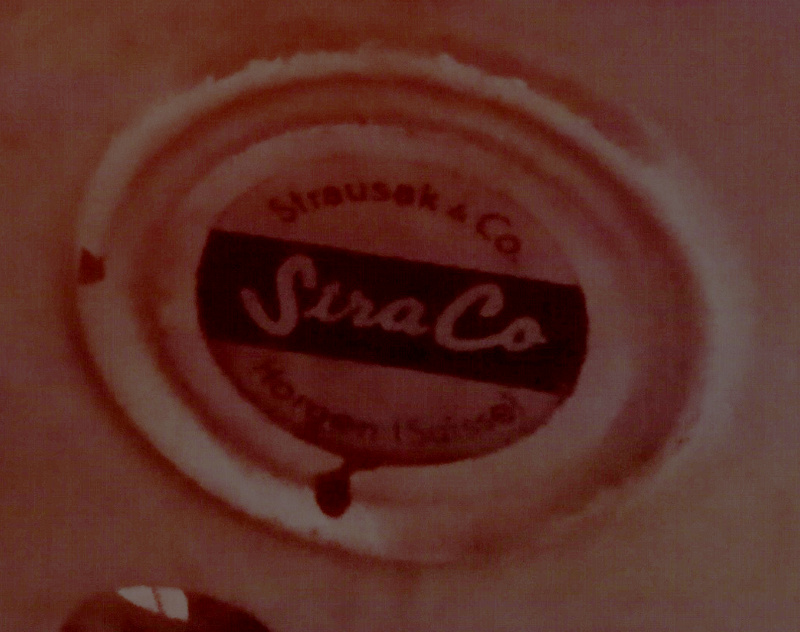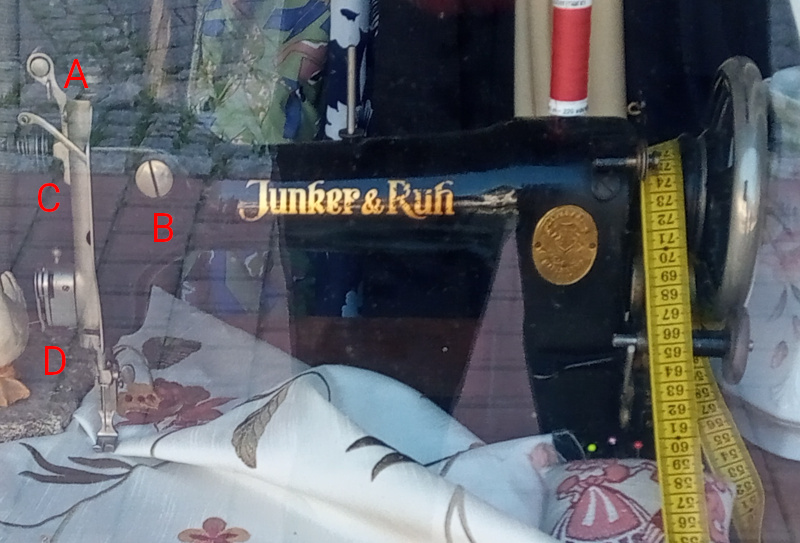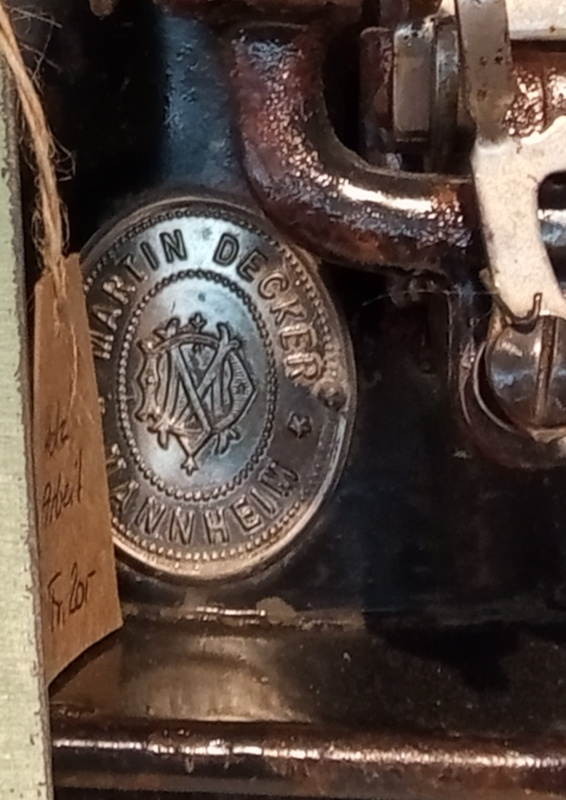Sewing machines of the Black Forest
What can you discover from a quick look?
My wife and I spent last week on vacation in the town of Schluchsee in the Black Forest region in Germany. It’s a beautiful area if you like forests, mountains, lakes, rivers, and waterfalls. We went hiking and bike riding and swimming - and sight seeing.
In the course of our sight seeing, we visited museums and went window shopping.
Along the way, I ran into more vintage sewing machines than I would have ever expected. It seems like once you notice them they are everywhere.
I thought it would be kind of fun to look up each machine I saw and see what I can find with the photos I could quickly snap with my phone.
It started the day we checked into the hotel “Haus Sonneck” just outside of the town of Schluchsee.
Standing in the vestibule of the hotel was this beauty:
| L.O. Dietrich Vesta vibrating shuttle |
|---|
 |
 |
That’s a vibrating shuttle sewing machine manufactured by the company Leopold Oskar Dietrich “Vesta-Nähmaschinen-Werke” (Vesta sewing machine factory.)
As with most of the machines I made pictures of on this vacation, I didn’t get to turn it over and around to look for the serial number. Usually, if you want to determine how old a sewing machine is you find the serial number and look it up in a table somewhere. As far as I can tell, there isn’t a list of serial numbers for the Vestas. The best I could find was the L.O. Dietrich page on the NeedleBar site.
With the information on the NeedleBar page about the L.O. Dietrich Vesta logos, you can date this machine to approximately mid 1920s to about 1932.
I got to ask the owner of the hotel about this particular machine. The hotel owner is from the Netherlands. Her grandmother bought the machine in the Netherlands sometime in the 1930s. The hotel owner inherited it from her grandmother and brought it with her when she and her husband took over the Haus Sonneck hotel sixteen years go. The machine was manufactured in Altenburg, Germany. It was sold in the Netherlands, stayed there for at least 75 years, then returned to Germany to spend the last sixteen years decorating a hotel in the Black Forest.
If you look closely at the user’s guide there, you will see that it is in Dutch, not German.
If I were trying to start a collection, I could have added this machine to it. The hotel owner offered to let me have it - she hasn’t really got a use for it but doesn’t want to scrap it because it belonged to her grandmother. I had to decline, though. I’ve got too many projects cooking as it is, and not enough room to keep more than the three machines my wife and I already own.
The day after we arrived, there was a rose festival in the nearby town of Nöggenschwiel. (If you can’t pronounce it, don’t feel bad. My wife is German and she had a hard time pronouncing it.)
There was a parade with marching bands and all kinds of clubs and groups wearing traditional Black Forest garb. There were stands selling roses and handcrafts, and all kinds of neat stuff. I bought a new pair of clippers to replace the good ones I had (but lost) for cutting the roses in our front yard. (That was a very good idea. I had to cut nine buckets of wilted roses from the bushes in the yard when we got home.)
There was also this monster of an Adler industrial sewing machine being used as a decoration in someone’s front yard:
| Adler industrial sewing machine |
|---|
 |
 |
It appears to be some variant of the Adler 220.
I joked with my wife that the Adler was made to sew elephants together. It isn’t (quite) really big enough for that, but is is intended for rather large tasks. The pages I’ve found selling old Adler 220 machines mention upholstery and tarps (the kind you use to cover the bed on a big rig truck.) I even found one guy using them to sew patches onto the backs of leather jackets for bikers - the big bed and the long neck let him lay the jackets flat while sewing rather than having to roll and unroll the jackets to make them fit the harp space on a smaller machine.
I have no idea when this particular machine was made. Adler seems to have made them for a long time - I saw purely mechanical Adler 220 machines like this stodgy gray one and others that had electronic displays mounted on them and a more modern paint job.
According to this list published by the company of Dürkopp Adler AG (the currently active descendant of Kochs-Adler,) the Kochs-Adler 220 was manufactured until 1984. That leaves plenty of time for it to go from purely mechanical to computerized. That list (all 72 pages of it) tells you the basic data of a good many Adler sewing machines.
I can’t tell from my (admittedly fuzzy) photos if this particular machine uses a single or double needle. The length is rather obvious, though. It’ll either be an Adler 220/76-72 (single needle) or 220/76-272 (double needle.) The “76” refers to the 76 cm (30 inch) harp space. The main differences between the 220 models seems to be the harp space (35, 50, or 76 cm) and whether it used single or double needles.
A couple of days later, we visited the Hüsli museum in Rothaus. Amongst a great many interesting things was this pretty little machine:
| Grossmann Dresdensia B |
|---|
 |
The Dresdensia B is a chainstitch machine, used to sew straw ribbons together to make fancy straw hats. First you weave a strip of straw about a centimeter wide (3/8 inch) and about 30 meters long (about ninety feet,) then you sew the strip together in a spiral with this chainstitch machine to make the hat. From what I’ve read and some pictures I’ve found, the hat was somewhat shaped during the sewing then steamed into its final shape.
The ISMACS site doesn’t have a lot of detail about the Dresdensia. Surprisingly, there’s not much else to be found about it on German sites, either. There’s a few people who own them and have written about them, but not much on the sites that compile information about old sewing machines (such as Naemaschinenverzeíchnis.de.) The Dresdensia was a special purpose machine, so maybe there just weren’t enough of them around to be of interest to collectors.
The places that do mention the Dresdensia usually give a manufacturing date of “around 1900.” I expect they were made earlier. It seems to be a copy of the Wilcox and Gibbs “visible stitch” sewing machine for straw hats. Given that the Wilcox and Gibbs machine came out in 1875, I expect production of the Dresdensia started not too long after that.
We visited what was supposed to be a mill museum on the same day we visited the Hüsli museum. The museum was in the building of an old mill. The overshot water wheel was still in place and actually turned under a trickle of water from a garden hose hidden in the wooden headrace. It wasn’t in functional shape, though. The wheel was unbalanced, and alternated between running forwards and running backwards. The rest of the “museum” was as unimpressive as the mill - when viewed as a gristmill museum.
Most of the mill museum was a store selling typical souvenir stuff - including jars of “groundhog salve” which contain an unspecified amount of groundhog fat.
There were two rooms besides the sales room where the works of the old mill should have been. These two rooms were filled with a random assortment of old tools and equipment.
Given the content of those rooms, they probably ought to have just called it a sewing machine museum and been done with it. There were six different sewing machines ín the museum.
Actually in the sales room was this Kayser vibrating shuttle sewing machine:
| Kayser vibrating shuttle |
|---|
 |
 |
 |
Like all of the machines in this “museum,” I couldn’t search for the serial number. Not that it matters much as I haven’t been able to locate a list of Kayser serial numbers - there’s no way to date this one based on the serial number.
What I have been able to discover is that Kayser fused with Gritzner in 1931. A machine with the Kayser name is therefore (probably) manufactured before 1931.
The first sewing machine in the “museum” rooms was a Pfaff 31, much like the one my daughter has:
| Pfaff 31 |
|---|
 |
The black handwheel makes it likely to be one of the “mourning” machines built during World War 2, like the Pfaff 30 I worked on a while back.
Next up is a Gritzner transverse shuttle with a fiddle base:
| Fiddle base Gritzner |
|---|
 |
 |
This machine is the only one that could be said to “be at home.” Gritzner was based in Durlach, Germany in the state of Baden. Baden is now part of the state of Baden-Württemberg. The Black Forest is located in the western half of Baden-Württemberg - the part formerly known as Baden. Durlach is around 200 kilometers (120 miles) north of the Schluchsee area where I saw this machine. In the more than 120 years since it was manufactured, it never managed to leave the region it was manufactured in.
According to this German Nähmaschinenverzeichnis (sewing machine index) page, Gritzner manufactured fiddle base transverse shuttle machines from 1872 until about 1900 - though they did produce some rectangular base transverse shuttle machines later. After 1900, the transverse shuttle machines were all rectangular base.
This Kochs-Adler machine is (according to the sign) a saddler’s sewing machine (Sattler.)
| Adler 5-39 sack sewing machine |
|---|
 |
 |
 |
According to the previously linked list of Adler sewing machines, the 5-39 is actually for sewing sacks. That makes sense, at least in the sense that a gristmill making flour from grain would have also manufactured their own cloth sacks.
This next machine is a special use machine made by Strausak and Company in Horgen, Switzerland. Strausak eventually turned in to the current company of BroachTec AG. This machine had to have been manufactured sometime between 1947 and 1983 since Strausak and Company was founded in 1947 and converted to a stock holder company in 1983. That’s close enough to “vintage” (if you kind of squint and go “eh, ok.”)
Horgen, Switzerland is only 90 kilometers (55 miles) from Schluchsee, Germany. This machine would almost be “at home” if it weren’t for the national border of Germany and Switzerland in between.
| Strausak sack sewing machine |
|---|
 |
 |
 |
The label on this machine is almost right. It says “sack sewing machine.” What it is, is a chain stitch machine for sewing the full flour sacks shut. It has a wheel with some truly vicious looking spikes to help pull the full sack through the machine rather than the usual wimpy feed dogs you see on normal sewing machines. You need that spiked wheel because the full sacks would weigh 25 kg (55 pounds) or 50 kg (110 pounds.)
The fact that it is chain stitch probably requires a little bit of explanation.
Strausak made a chain stitch machine on purpose. Chain stitches come undone easily if you break the chain, but so long as the chain is intact the stitches hold really well - the full load of a 110 pound sack of flour won’t cause the sack to pop open. The cool thing about the chain stitch is that if you cut the knot at one end then pull on the string, the whole thing comes undone rather easily. This is a good thing when you are manhandling 110 pounds of flour and trying to dump it into an industrial mixer. Heave it into place, break the thread, pull, zip (the whole seam unravels,) and 110 pounds of flour pour out of the sack.
Even today, large sacks of flour and other powders are packed in sacks with the final seam chain stitched.
Lest you think “Strausak” is some funky Swiss word related to “sacks,” I must say that “Strausak” appears to be a normal (if not especially common) family name in Switzerland.
This final item from the mill museum is a mislabeled machine whose manufacturer I can’t identify.
| Unknown patcher |
|---|
 |
The tag on this one says it is a sack sewing machine, but its construction is typical of a shoe maker’s patcher. The long, skinny free-arm is something you’ll often see on patchers. Another argument in favor of “patcher” is the gizmo on the left hand edge of the table. That appears to be for punching holes or crimping eyelets - neither of which you’d need for sewing flour sacks, but either of which could be useful when making leather items. I think the tags simpy got swapped between this machine and the Adler 5-39.
The day after we visited the museum, we ended up in the town of Sankt Blasien. Besides visiting the (quite imposing) Catholic church, we also went window shopping.
In the window of a second hand clothing store was this Junker & Ruh class 8 doing duty as an eyecatcher for an advertisement for a local tailor - buy your second hand clothes then take them to have them fitted at the tailor.
| Junker & Ruh |
|---|
 |
 |
 |
The Junker & Ruh class 8 is a cousin to my Adler class 8. They use the same mechanism and the same oddball “bagel” bobbins. The give-away is mostly in the head of the arm. The class 8 machines all seem to use the same setup on the outside to go with their odd setup on the inside.
Class 8 machines tend to have a pretensioner (A,) a large screw (B) for the left facing take-up lever (C) and a really complicated “thread controller” (D.) I’ve never seen that combination on anything except the Wheeler and Wilson 9 rotary hook style machines - that means the German made class 8 machines and the UK made Jones’s Spool machines.
Two other things you’ll notice are the square necked presser feet, and in the machines with the spool holder a sort of cutout in the table top to pass the spool holder when you tip the machine back.
On the day we visited the Rhine Falls (just across the border from Germany in the Swiss canton of Schaffhausen,) we also visited the town of Stein am Rhein and went window shopping (again.) Besides a sadly misplaced western store (where you can buy cowboy hats and pointy-toed cowboy boots made in Mexico and imported to Europe by a German company,) we also wandered into a handcrafts store with this Martin Decker vibrating shuttle sewing machine as decoration.
| Martin Decker vibrating shuttle |
|---|
 |
 |
This Decker seems to have seen some pretty heavy use.
I couldn’t find much about Decker machines, until I found a hint on the German Nähmaschinenverzeichnis indicating that Martin Decker was a dealer who sold rebadged Gritzner machines. If I could have taken a picture of the serial number, I could have then (approximately) dated it using this list of serial numbers on the fiddlebase site.
On the drive back home, we took the scenic route (avoiding major highways) and went through the town of Triberg. The town of Triberg is known for two things: cuckoo clocks and a waterfall.
Most of the clocks these days are sold in tourist traps on the main street in town, but there are a few workshops run by craftsmen.
I spotted this Singer 15 in one of workshops:
| Singer 15 |
|---|
 |
 |
A sewing machine looks kind of out of place in a shop selling clocks in hand carved wooden housings. I asked the owner, and he told me that the machine had belonged to his grandmother. They brought it down from the attic and put it in the show room when they started selling clothing articles (T-shirts and replicas of traditional clothing.) No, I didn’t buy a Black Forest T-shirt from him.
There were many models of Singer 15 made. I don’t know enough about them to recognize the variants. The serial number is stamped into the machine below the brass Singer emblem. If I had made a picture of the serial number, I could have looked it up on the ISMACS Singer serial number page to find out when it was made and what exact Singer 15 variant it was.
It turns out you can learn a lot of stuff about old sewing machines just by searching the internet using hints from quick snapshots.
If you are trying to identify a particular machine, it helps to look for a manufacturer’s name on the machine and any markings that indicate a model number or a serial number. It often helps to use the image search on Google - that’s how I originally learned what model my own Adler class 8 is.
At any rate, I hope you enjoyed a look at the sewing machines that crossed my path in the Black Forest.